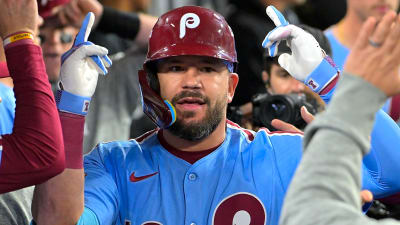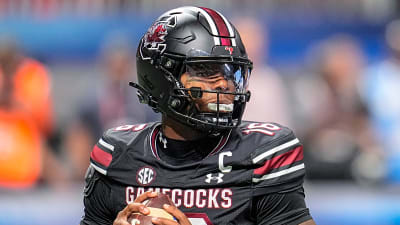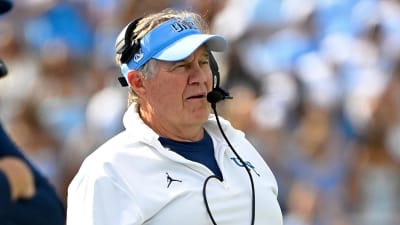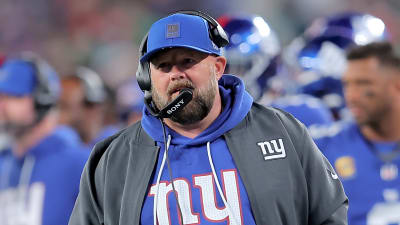
The New York Jets’ nightmare scenario has come true: They must try to replace the more irreplaceable wideout in the NFL.
After suiting up for the first 57 games of his NFL career, Garrett Wilson is expected to miss at least the next couple of games due to a knee injury. It leaves the Jets’ coaching staff scrambling to replace a player responsible for a league-high 64% of his team’s targets to the wide receiver position.
Through six games, Wilson has over four times as many targets (56) as the Jets’ second-leading wide receiver, Josh Reynolds (12). Wilson has accounted for 64% of the unit’s receptions, 68% of its receiving yards, and 80% of its touchdowns.
Replacing that production is a monumental task, especially after a game in which the Jets set a franchise low with -10 passing yards. (Yes, there is a minus sign in front of the 10.)
As daunting of a challenge as it seems, it is also a fantastic chance for the Jets’ spiraling coaching staff to make a statement. If Aaron Glenn can lead his team to offensive success without the wide receiver who has single-handedly carried the passing game, it would be a much-needed feather in the cap of a coach who is careening toward Gus Bradley and Hue Jackson territory.
Most likely, the Jets will try and use a committee approach to replace Wilson’s production. They don’t have one single player who is capable of replicating Wilson’s numbers.
However, it is clear which player should be the team’s primary target on the outside, even if he isn’t quite used to a Wilson-esque target share: Arian Smith.
The Jets’ speedy fourth-round rookie has been open all year, but due to Justin Fields’ processing issues, Smith has only been targeted six times, catching four passes for 24 yards. Three of those four receptions came from Tyrod Taylor.
In New York’s recent loss to Denver, Smith was open for numerous downfield opportunities, but Fields never took advantage. Now, with Wilson sidelined, the Jets should roll the dice on their high-ceiling rookie and hand him the keys to the passing game in Week 7.
It might seem early to thrust a fourth-round rookie into the WR1 throne, but the Jets made this bed for themselves when they decided not to solidify their wide receiver depth in the offseason. Players like Reynolds, Allen Lazard, and Tyler Johnson do not have the speed and explosiveness to step into a primary role. That leaves Smith as the clear-cut best option to anchor the passing game if the Jets want to give themselves any chance of fielding a respectable offense.
When looking back at the All-22 film from the Jets’ trip to London, it is apparent that Smith offers intriguing upside as a primary outside receiver in Wilson’s absence. The only question is whether Fields will throw him the ball.
Well, the other question is whether Smith would catch those passes, as he hasn’t received enough opportunities to quell the drop concerns that sent him to the fourth round. But the Jets need to get the rookie some opportunities before they can evaluate that part of his game. Now is the time to do it.
Let’s take a look back at the opportunities Smith created against Denver.
Arian Smith’s All-22 film vs. Broncos
With the Broncos playing single-high, Smith draws a one-on-one on this go route against off coverage. He eventually clears the defender for a yard of vertical separation.
Given that this is third-and-13 and the Jets protected Justin Fields fairly well, I would have loved to see Fields take this shot, even if it’s after he escaped the pocket. At the very least, there would be a good chance of drawing a pass interference penalty due to Smith’s speed; he gets on top of the defender, which means any underthrow would have a high probability of a penalty.
Fields also had a chance to dump this to Mason Taylor after scrambling, but he decided to tuck and run, bypassing any throwing options.
We know Smith has game-breaking speed (4.36 forty time), but if he wants to be a reliable high-volume target in the NFL, he must also master the nuances of his position.
This play is a good sign in that department. Smith settles between the two linebackers in zone coverage to present himself as a checkdown option. Unfortunately, left guard John Simpson is beaten quickly, and Fields is forced into a panicked decision.
Running a dig against off coverage on the back side, Smith does a nice job of selling vertically to keep the defender honest, and he makes a sharp in-cut to open himself up.
Fields elects for a two-yard throw in the flat on first down. The right play, though, was Garrett Wilson in the slot. Wilson draws a one-on-one with no help over the top, as the safety rotates down. You would love to see Fields recognize the safety dropping and take the shot to Wilson on the corner route.
While it’s not as if Smith “should” have been targeted on this play (he was on the back side of the concept), it’s still a good example of the opportunities that Smith can create. The respect he demands as a deep threat can open up plenty of opportunities for him to get open in the intermediate range.
This was Smith’s lone target of the game. Fields takes a vertical shot on third-and-5, but overthrows him by too much for Smith to have any chance. The overthrow also negates any chance of a pass interference.
It’s far from Smith’s best route, as Riley Moss covers him up well, but a better throw can still give Smith a chance to make a play or at least draw a flag. With Smith’s speed, cornerbacks can easily succumb to panic mode when the ball is in the air. The Jets have to take advantage by giving him catchable throws.
In fairness to Fields, a poor rep by right guard Joe Tippmann resulted in a hit that prevented Fields from having a clean pocket. That pressure was created by quarterback-hit machine John Franklin-Myers, whom Joe Douglas traded for a bag of Cool Ranch Doritos. Dumping JFM was the start of the Jets’ defensive downfall.
The Jets put Smith in pre-snap motion, and they get a man-coverage tell as the cornerback (Jahdae Barron) follows him across the formation. Smith uses the motion to accelerate into a vertical route, where he does a nice job of using physicality to deflect Barron and create some separation.
Drawing Cover 1 Man with a pre-snap man coverage tell, this was a good chance for Fields to take a first-down shot that could wake up New York’s dormant offense. Instead, he holds the ball and takes a sack.
It seems like Fields was focused on Garrett Wilson, who came open on the dig, but Fields did not pull the trigger. To be fair, Josh Reynolds was very slow to run his clear-out, so Fields may have been deterred by Reynolds potentially getting in Wilson’s way. By the time Fields could be sure that Reynolds would not bump into Wilson, the pressure got home, and there wasn’t much left that Fields could do.
But it all could have been avoided if Fields had taken advantage of a favorable shot opportunity that was tipped off pre-snap. If the Jets want to get more explosive plays out of their passing game, the opportunities are there; they just need their quarterback to pull the trigger and stop being so conservative.
It’s third-and-7, and the Jets are driving at the end of the first half with under 40 seconds left and no timeouts. The priority here should be to get a chunk gain that moves the chains and gets the team into field goal range, preferably along the sidelines to stop the clock.
A perfect window opens up. Smith runs an out-and-up, and the Broncos bust the coverage, leaving him wide open. Fields can either give Smith a back-shoulder ball to settle between the zones and get out of bounds, or take a vertical shot to challenge the safety, who also has to worry about Wilson in his area.
Instead, Fields checks the ball down well short of the sticks, and Reynolds comes up short. The Jets end up letting the clock run out to end the half.
There isn’t much special on display from Smith here, but it is another play proving that New York has plenty of opportunities to let its 4.36 rookie make plays down the field.
Similar to the play from earlier, it’s another back side dig in which Smith gets open against soft coverage. Fields gets the first down anyway, so there is no fault on the QB here, but we get another example of potential from Smith that strengthens his case to carry a heavy workload moving forward.
Here is another example of Smith showing some awareness. He runs a drag route and sits in the hole of the zone coverage between the two linebackers. With this being third-and-5, Smith could have caught this and fallen backward for the first down if Fields had hit him early enough, but Fields takes the sack. At the very least, it could have set up a manageable fourth down.
Mason Taylor is also open in the flat for a potential first down, and Fields looks at it, but doesn’t pull the trigger.
While it is a stretch to say that Smith “should” have been targeted on this first down play, as he is far from “wide open” and the safety rotates in his direction, it still shows the potential Smith offers as a vertical threat.
After the initial jam from Moss, Smith’s speed takes center stage. Watch how quickly he accelerates past Moss once he passes the 30-yard line. This is against a cornerback in Moss who owns a 9.68 Relative Athletic Score, highlighted by an elite 1.49 ten-yard split (92nd percentile among cornerbacks).
If the Jets pepper Smith with a high volume of deep targets, there is a good chance it will yield positive results at a high rate. The lone concern is whether Smith has the hands to catch those balls consistently, but there is only one way to find out.
More must-reads:
- How Patriots' Drake Maye is reminding Hall of Famer of Tom Brady
- Rival executives rave about Buccaneers' Baker Mayfield amid MVP talk
- The 'NFL total touchdown pass leaders' quiz
Breaking News
Trending News
Customize Your Newsletter
 +
+
Get the latest news and rumors, customized to your favorite sports and teams. Emailed daily. Always free!








